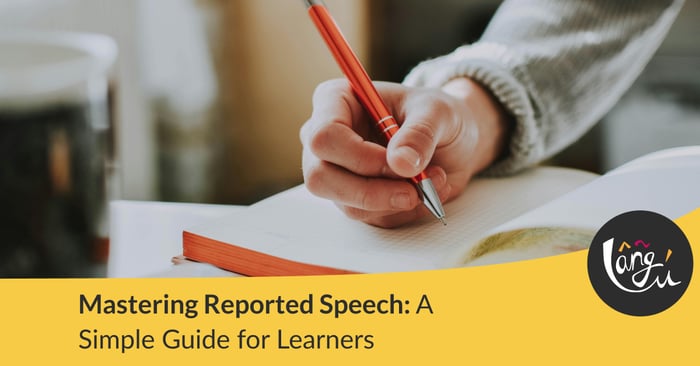Table of Contents
What Is Reported Speech?
Reported speech (also known as indirect speech) is how we express what someone else said without quoting them directly. Instead of repeating their exact words, we summarize or paraphrase the original message.
Direct speech: She said, “I’m tired.”
Reported speech: She said (that) she was tired.
Simple, right? Yet many learners struggle with the changes in verb tenses, pronouns, and time expressions. This guide will walk you through how to master reported speech and avoid the most common pitfalls.
Why Reported Speech Matters
It is everywhere—in conversations, news stories, academic writing, and business communication. It helps us:
Talk about what others said
Tell stories and recount past events
Share information efficiently
If you're serious about improving your English fluency, mastering this speech is essential.
The Golden Rule: Backshifting
When converting direct speech into reported speech, one key rule is backshifting—changing the verb tense back in time. Here’s how it works:
| Direct Speech | Reported Speech |
|---|---|
| “I am happy.” | She said she was happy. |
| “They go to school.” | He said they went to school. |
| “We have seen it.” | They said they had seen it. |
Exceptions to Backshifting
There are exceptions when backshifting isn’t required:
If the reporting verb is in the present tense:
He says he is tired.If the information is still true:
She said the sun rises in the east.
Don’t overthink it. If the sentence still makes sense without changing the tense, it's probably fine as is.
Changing Pronouns and Time Expressions
Besides verb tense, you also need to adjust pronouns and time references:
Pronouns
Change them based on the speaker and the listener.
“I love this book,” said Sarah.
→ Sarah said she loved the book.“You need to study more,” the teacher told me.
→ The teacher told me I needed to study more.
Time Expressions
Time markers shift too:
| Direct Speech | Reported Speech |
|---|---|
| today | that day |
| tomorrow | the next day |
| yesterday | the day before |
| now | then |
| this week | that week |
Example:
“I’ll finish it tomorrow.”
→ He said he would finish it the next day.
Reporting Questions
Reporting questions involves two main changes:
Switch the word order (no auxiliary verbs like do/does/did).
Use appropriate question words (what, where, why, etc.) or “if/whether” for yes-no questions.
Wh-Questions
“Where do you live?”
→ She asked where I lived.“What time is it?”
→ He asked what time it was.
Yes-No Questions
“Do you like coffee?”
→ She asked if I liked coffee.“Will you be there?”
→ He asked whether I would be there.
Reporting Commands and Requests
Use verbs like tell, ask, advise, warn, or order, followed by the to-infinitive.
“Please sit down.”
→ She asked me to sit down.“Don’t touch that.”
→ He told me not to touch it.
This structure is useful in both formal and informal English. Just make sure you choose the correct reporting verb for the tone.
Common Mistakes
Even advanced learners slip up here. Let’s highlight a few pitfalls to avoid:
1. Forgetting to Change Tense
Wrong: He said he is tired.
Right: He said he was tired.
2. Using the Same Pronouns
Wrong: She said I was late.
Right: She said she was late.
3. Keeping Direct Word Order in Questions
Wrong: He asked where do you live?
Right: He asked where I lived.
4. Skipping “If” in Yes/No Questions
Wrong: She asked I was coming.
Right: She asked if I was coming.
Practice makes perfect. The more examples you review and rewrite, the more natural your sentences will become.
Quick Practice: Convert These Sentences
Try converting these into reported speech:
“I’m learning English,” she said.
“Do you like pizza?” he asked.
“Don’t be late,” Mom told me.
“We saw that movie last night,” they said.
Answers:
She said she was learning English.
He asked if I liked pizza.
Mom told me not to be late.
They said they had seen that movie the night before.
Tips to Master Reported Speech
Listen actively: Notice how native speakers report speech in conversations or interviews.
Practice rewriting: Take quotes from books or news and convert them.
Record yourself: Speak out your transforrmed sentences aloud. It helps reinforce the structure.
Use a grammar checker: Tools like Grammarly can catch basic errors.
Work with a teacher: Personalized feedback is the fastest way to improve.
Summary:
Reported speech is a powerful tool for sharing stories, information, and conversations. Once you get the hang of backshifting, pronoun changes, and question structure, it becomes second nature.
If you’re still unsure or want to speed up your progress, working with a professional English teacher can make a huge difference.
🚀 Book a lesson on Langu today and get real-time help with grammar and more!
FAQs
What is the difference between direct and reported speech?
Direct speech quotes the exact words someone said using quotation marks, while reported speech summarizes or paraphrases what was said without quoting it directly. For example:
Direct: She said, “I’m busy.”
Reported speech: She said she was busy.
Do I always need to change the verb tense in reported speech?
Not always. You typically shift the tense back when the reporting verb is in the past, but if the statement is still true or the reporting verb is in the present, reported speech may keep the original tense.
Example: He says he likes music (no change because "says" is present).
Can I use reported speech in formal writing?
Absolutely. Reported speech is widely used in academic papers, news articles, and professional reports. It allows you to reference what others have said without quoting them directly, keeping your writing clear and concise.




